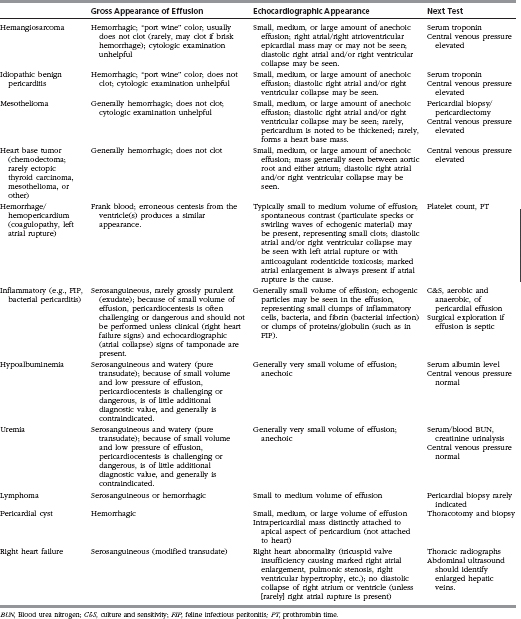P
Panting
Paraneoplastic Syndromes
| Paraneoplastic Disorder | Clinical Features | Associated Neoplasms in Companion Animals |
|---|---|---|
| Malignancy-associated hypercalcemia | Dehydration, depression, muscular weakness, anorexia, polyuria and polydipsia, vomiting, arrhythmias | Lymphoma (thymic, multicentric, extranodal leukemia), carcinomas (nasal, pulmonary, mammary, squamous cell, thyroid, apocrine gland of anal sac, gastric, pancreatic, testicular, parathyroid gland), thymomas, multiple myeloma, epidermoid carcinoma of the lung |
| Extrapancreatic hypoglycemia | Weakness, seizures | Hepatocellular carcinoma, hepatoma, hemangiosarcoma, leiomyosarcoma, splenic hemangiosarcoma, salivary gland adenocarcinoma, metastatic oral melanoma, mammary carcinoma, pulmonary carcinoma, plasma cell tumor, lymphocytic leukemia, renal carcinoma |
| Hyperhistaminemia, mast cell degranulation | Gastrointestinal ulceration with melena and hematemesis, urticaria, erythema, pruritus, poor wound healing, anaphylactoid reaction, hypotension/arrhythmias, altered coagulation | Mast cell tumor |
| Cancer anorexia/cachexia syndrome | Weight loss >5%-10% body weight, anorexia >2-3 days’ duration, early satiety | Any tumors |
| Syndrome of inappropriate antidiuretic hormone secretion | Hyponatremia, polyuria and polydipsia, edema | Pulmonary carcinoma (dog) |
| Fever | Persistent pyrexia >39.7°C (103°F) without infection | Lymphoproliferative and myeloproliferative neoplasms; mast cell, hepatic, and brain tumors |
| Polycythemia | Exercise intolerance, seizures, red mucous membranes, packed cell volume >60 | Renal tumors, lymphoma, polycythemia vera, hepatic tumors |
| Hypertrophic osteopathy | Painful, hard, swollen distal limbs, reluctance to walk | Primary lung tumors, rhabdomyosarcoma (bladder), esophageal sarcomas, pulmonary metastasis, carcinoma, renal carcinomas, hepatic adenocarcinoma, renal papillary adenoma (cat), Sertoli cell tumor, transitional cell carcinoma of bladder, adrenocortical carcinoma |
| Dermatologic disorders | Nodular dermatofibrosis, erythema, flushing, necrolytic migratory erythema | Renal cystadenocarcinoma, mast cell tumor, pheochromocytoma, pancreatic adenocarcinoma |
| Renal disorders | Amyloid deposition, glomerulonephritis, concentrating defects, proteinuria, nephrotic syndrome | Many tumors, including lymphoma, plasma cell tumors, mast cell tumors |
| Central nervous system dysfunction | Tissue hypoxia with or without thromboembolism, due to hyperviscosity syndrome (seizures, dementia) | Lymphoma, plasma cell tumors |
| Peripheral nervous system disorders: | ||
| Neuromuscular junction | Myasthenia gravis (weakness with exercise that improves with rest) | Thymoma, hepatocellular carcinoma, osteosarcoma, mammary adenocarcinoma, pheochromocytoma, pulmonary adenocarcinoma |
| Neuropathy | Weakness, cranial nerve abnormalities | Lymphoma, bronchogenic carcinoma, insulinoma, leiomyosarcoma, hemangiosarcoma, and undifferentiated sarcomas |
| Neuromyopathy | Weakness, muscle pain, proprioception deficits | Pulmonary carcinoma |
| Myopathy | Myositis | Thymoma |
With permission from Bonagura J: Kirk’s current veterinary therapy XII: small animal practice, St Louis, 1995, Saunders, p 531.
Pericardial Diseases
Peritonitis
Petechiae, Ecchymosis
Pneumonia, Aspiration
Pneumonia, Bacteria Isolated in Tracheal Aspirates from Dogs
| Bacteria | Range Percentage (%) |
|---|---|
| Gram Negative | |
| Escherichia coli | 17–43 |
| Klebsiella | 3.9–23 |
| Bordetella | 3–23 |
| Pseudomonas | 4.9–33 |
| Pasteurella | 0–45 |
| Enterobacter | 0–5 |
| Acinetobacter | 0–7 |
| Moraxella | 2–26 |
| Other gram-negative rods | 4.4–12 |
| Gram Positive | |
| Staphylococcus | 5.4–27 |
| Streptococcus | 13.8–47 |
| Nonhemolytic | 0–13 |
| α-Hemolytic | 3–30 |
| β-Hemolytic | 0–16 |
| Corynebacterium | 0–5 |
| Mycoplasma | 2.9–100 |
| Anaerobes | |
| Total | 18.7 |
| Bacteroides | 23.7 |
| Clostridium perfringens | 5.3 |
| Eubacterium | 2.6 |
| Fusobacterium | 15.8 |
| Peptostreptococcus | 23.7 |
| Prevotella | 5.3 |
| Porphyromonas | 15.8 |
| Propionibacterium | 2.6 |
From pharyngeal isolates, Mycoplasma are isolated 85.7%-100% of the time, representing normal microflora; from transtracheal washings, 34%-69%; from bronchiolar washings, 7.1%-26.9% (Jameson et al., 1995; Randolph et al., 1993). A range is not listed for anaerobes because data are from one study of 203 dogs (Angus et al., 1997); Data taken from Creighton SR, Wilkins RJ: Bacteriologic and cytologic evaluation of animals with lower respiratory tract disease using transtracheal aspiration biopsy. J Am Anim Hosp Assoc 10:227–232, 1974 (30 dogs); Harpster NK: The effectiveness of the cephalosporins in the treatment of bacterial pneumonias in the dog. J Am Anim Hosp Assoc 17:766–772, 1981 (30 dogs); Thayer GW, Robinson SK: Bacterial bronchopneumonia in the dog: a review of 42 cases. J Am Anim Hosp Assoc 20:731–735, 1984 (42 dogs); Hirsh DC: Bacteriology of the lower respiratory tract. In Kirk RW (ed), Current veterinary therapy IX. Philadelphia, 1986, WB Saunders, pp 247–250 (105 dogs); Jameson PH, King LA, Lappin MR, et al: Comparison of clinical signs, diagnostic findings, organisms isolated, and clinical outcome in dogs with bacterial pneumonia: 93 cases (1986-1991). J Am Vet Med Assoc 206:206–209, 1995 (48 dogs); Angus JC, Jang SS, Hirsh DC: Microbiological study of trans-tracheal aspirates from dogs with suspected lower respiratory tract disease: 264 cases (1989-1995). J Am Vet Med Assoc 218:55–58, 1997 (203 dogs); With permission from Greene C: Infectious diseases of the dog and cat, ed 3, St Louis, 2006, Saunders, p 870.




